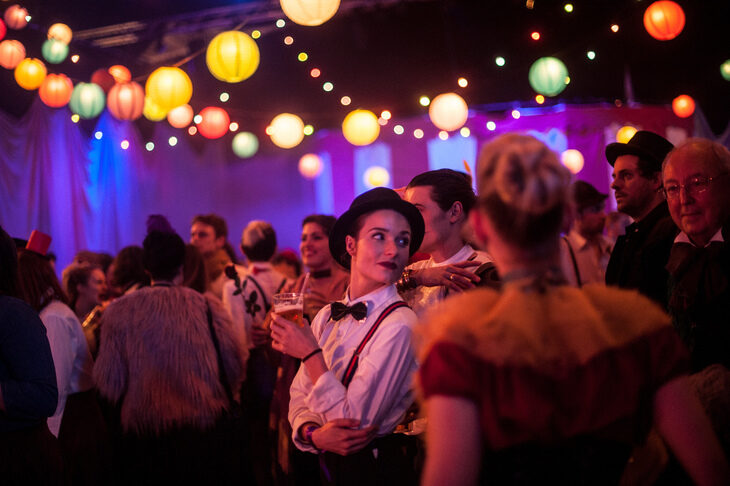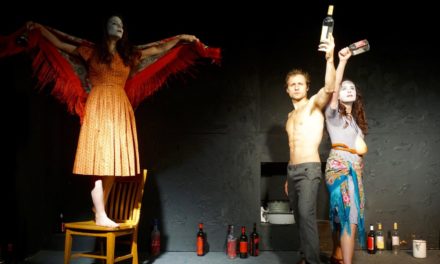At the core of Secret Cinema, there is the promise of daring to be different. Combining the realms of large cinema screenings, theatre and immersive spaces, they offer unique experiences surrounded by mystery. Most reviewers keep the secrecy as to not spoil the event for others, so the audience can only speculate what they are in for from a few videos here and there, and word of mouth accounts. Since 2007, they have dared to approach epic films like Star Wars, Dirty Dancing, Back to the Future, The Third Man, and this year, Moulin Rouge. Although their reputation may demonstrate that each production has been moving and relevant, the way Secret Cinema approached Moulin Rouge seemed to offer more than just nostalgic entertainment. The whole event, from the moment you purchased your ticket, until the rolling credits, was framed so the juxtaposition of each experience layer would reveal a thrilling premise.
With the competition of television and the Internet, cinema has had to reinvent itself the same way theatre had to when the movies appeared as a new compelling way of storytelling. Back at the beginning of the 20th century, as a result, theatre strengthened what differentiated it from movies: the live, close distance of the event, the theatricality. This has led to a rich century of reinvention with the theatre of the absurd, the avant-garde, immersive theatre among others, each trend a way to capitalize on what makes theatre unique. What Secret Cinema is doing with its “live cinema” is to take advantage of what theatre has learned and add it to solve the problem of cinema screenings. With technology always competing for our attention, becoming truly lost in a story becomes harder. So new audiences, hungry for stronger, closer, enveloping stimuli respond to what Secret Cinema is creating.
Smartly, Secret Cinema productions revolve around well-known, cult-provoking films. Instead of connecting for the fist time with the material, the audience tends to have a relationship with it. Avid theatergoers have a similar relationship with Shakespeare, but each time a theatre fan goes to see a new production of Hamlet or Romeo and Juliet, they expect to see something different. However, Moulin Rouge as a story has been the same since its release, and the only source of freshness in the experience of watching the film comes from the circumstances around it. Secret Cinema is well aware of the power of those circumstances. It is in its use of them that their genius resides.
It has been more than 15 years since Moulin Rouge was created. A majority of Secret Cinema’s target audience (people in their late 20s-30s) were teenagers when the movie was released and probably received its story with romantic, idealistic perspective. The bohemian motto of “Truth, Freedom, Beauty, and Love,” appeared attainable by how abstract it seemed. And when they learned “Come What May,” these hopeful teens sided with Satine and Christian in their quest for love above all things, love against the dirty power of the Duke. Thanks to Secret Cinema, the now-grown teenagers enter through the gates of Montmartre in the same way that Christian does at the beginning of the film. When they sing along with the cast “Come What May,” it echoes the dreams with which they learned it fifteen years ago. Nostalgia can be so powerful. But let us not be blinded by our memories and have a look at the current circumstances.
When you purchase your ticket for Secret Cinema, you choose the strata of society to which you will belong: Creatures of the Underworld, Children of the Revolution and Aristocrats. Each group has a different price range and unique perks associated with it. Being an Aristocrat, for instance, can cost up to 150 pounds and will entitle you, among other things, to a stack of Montmartre money that can be used in the immersive world. As counts, barons. and marquises, the actors acknowledge them as privileged guests. The Creatures of the Underworld, on the other hand, are given characters of dancers, actors, freaks, … and a little money. They stand on the patio during the screening, instead of comfortably in a chair like the Aristocrats. A class structure has thus been created, which can correspond to the purchasing power of audience members, but everyone will be part of the experience.
Watching the film as a bill-paying adult can be quite different from the first time you saw it. If one leaves the pre-existing relationship with the movie aside, critically examining the tension of the story can be quite interesting. Moulin Rouge is driven by the tension between love and comfort. While the character of the Duke is somewhat ridiculed and portrayed as quite disgusting (after all the movie does take a stand in this dilemma), what he offers Satine is not unappealing: security. He expresses this point of view in the movie, “Why should the courtesan chose the penniless sitar player over the maharajah who is offering her a lifetime of security?” On the other side of the equation, there is Christian, the penniless writer offering Satine freedom through love. She discovers and tells to Zidler, her boss,“ All my life you made me believe I was only worth what someone would pay for me. But Christina loves me. […] And that is worth everything.” The conflict at the core of the movie is, therefore, freedom through love against financial security. And our teenage self would take Christian over the Duke in a heartbeat.
But what about our adult self? In the midst of that crowd of Moulin Rouge fans, passionately singing “We are the Children of the Revolution,” how many of us have chosen a life of love and passion over security? How many have refused a finance job over a career in poetry? How many have dared to live differently, like Christian? In fifteen years, real life has changed the circumstances that inform our choices. We are unaware of this, so unaware that some fans will pay more to be Aristocrats, dukes, and counts in the Moulin Rouge world, to distinguish themselves from the crowd, to have money that, effectively, does not lead to a better experience in Montmartre. If one steps out of the crowd and the nostalgia and absinth-induced haze, the social statement is clearly there. As are the posters all over the Montmartre walls that remind us of the refugee crisis happening outside of this wondrous created world. The world created by Secret Cinema is not separate from the circumstances we are living outside of it.
Secret Cinema creates amazing entertainment. Each detail of the experience is curated and fun. There is music, there is alcohol, there is theatre and dance, there is cinema, but it is not all mindless and premise-less. With good immersive theatre, you can choose how much you can be immersed in the world. With Secret Cinema this potentiality extends to how much do you want to be hit by the experience. There is no moral judgment if you just sing at the top of your lungs and dance to the DJ in your can-can dress without worrying about further social implications –it is still so worth it. But if you do stop and think, there is also so much to reflect on who we are as humans, and who are we becoming as a generation.
This post was written by the author in their personal capacity.The opinions expressed in this article are the author’s own and do not reflect the view of The Theatre Times, their staff or collaborators.
This post was written by Aida Rocci Ruiz.
The views expressed here belong to the author and do not necessarily reflect our views and opinions.

















